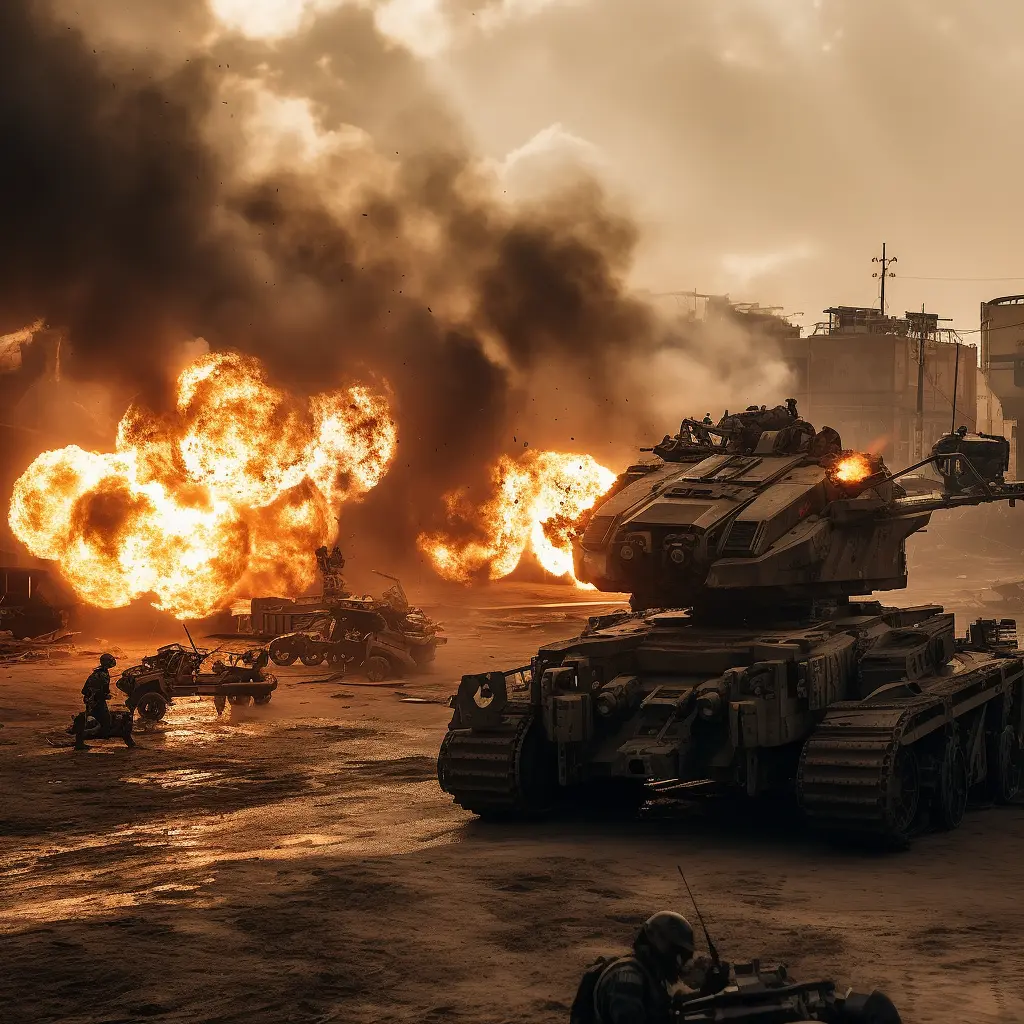As a concerned citizen and researcher, I’ve been delving into the world of artificial intelligence (AI) and its growing impact on modern warfare. The race for AI dominance has become a significant topic that explores how AI is transforming the nature and outcome of military conflicts globally. This article aims to provide an in-depth analysis of the current and potential applications of AI in various warfare domains, its strategic implications for global security and stability, and the ethical and legal challenges posed by AI in warfare.
AI has become a powerful technology that can provide a decisive advantage in military conflicts, enhancing speed, accuracy, efficiency, and effectiveness of operations while reducing human casualties and errors. However, it is also a disruptive technology that creates new vulnerabilities, uncertainties, and risks. AI introduces new forms of warfare, such as cyberattacks, information manipulation, and autonomous weapons, which challenge existing norms, laws, and doctrines. AI can also escalate conflicts by increasing the complexity, unpredictability, and opacity of military actions and decisions.

Currently, the US and China are leading the AI arms race, investing heavily in AI for military purposes to gain an edge over each other and other rivals. The EU, Russia, India, Israel, and other countries are also developing their AI capabilities for defence and security. The race for AI dominance could have profound consequences for international relations and world order.
The ethical and legal quandaries surrounding AI in warfare are vast and multifaceted. When machines are given the power to make life-and-death decisions, it becomes increasingly difficult to determine who bears moral responsibility for their actions—be it the programmer, the operator, or even the machine itself. Moreover, there is the issue of accountability. As AI systems become more complex and autonomous, tracing the decision-making process becomes increasingly challenging, potentially obscuring the chain of responsibility. Furthermore, the use of AI in warfare raises concerns about transparency, as many AI algorithms are considered proprietary or classified, making it difficult for external entities to evaluate their adherence to international law.
The deployment of AI in warfare also has profound implications for human dignity and human rights. The reliance on machines to conduct combat operations could potentially dehumanize the enemy, making it easier for soldiers and decision-makers to distance themselves from the consequences of their actions. Additionally, the use of AI in warfare may blur the lines between combatants and non-combatants, putting civilians at greater risk and potentially violating the principles of distinction and proportionality enshrined in humanitarian law. As a result, it is crucial for policymakers, military officials, and AI developers to thoroughly consider these ethical and legal concerns as AI technologies continue to shape the future of warfare.

AI Applications in Modern Warfare
Artificial Intelligence (AI) is revolutionizing modern warfare across various domains, including intelligence, surveillance, reconnaissance, command and control, cyberwarfare, autonomous weapons, and information warfare. These applications offer potential benefits in terms of increased efficiency, speed, and accuracy, while also raising concerns about ethical and legal implications.
- Intelligence, Surveillance, and Reconnaissance (ISR)
AI has the potential to significantly enhance ISR capabilities, which are crucial for situational awareness and decision-making in military operations. Machine learning algorithms can analyze vast amounts of data from various sources (e.g., satellite imagery, signal intercepts, and social media) to identify patterns and trends that may be relevant for military planning and targeting. This can lead to improved threat detection and assessment, as well as more efficient resource allocation.
- Command and Control (C2)
In the C2 domain, AI can help military commanders make better decisions by processing and synthesizing vast amounts of information in real-time. AI-powered decision support systems can assist in the development of optimal plans and strategies, taking into account factors such as enemy capabilities, terrain, weather, and friendly forces. These systems can also help maintain situational awareness and monitor the progress of ongoing operations, enabling commanders to quickly adapt to changing circumstances.
- Cyberwarfare
AI is playing a growing role in cyberwarfare, both as a tool for offence and defence. On the offensive side, AI can be used to automate cyberattacks, such as exploiting vulnerabilities in enemy networks, conducting distributed denial-of-service (DDoS) attacks, and spreading disinformation. On the defensive side, AI can be used to detect and counter cyber threats, such as identifying malware, monitoring network traffic for signs of intrusion, and automatically patching vulnerabilities.
- Autonomous Weapons
Autonomous weapons are a highly controversial and rapidly evolving application of AI in warfare. These systems can independently identify, track, and engage targets without human intervention. Examples include AI-powered drones, robotic ground vehicles, and swarms of small unmanned aerial vehicles (UAVs) that can coordinate their actions to perform complex tasks.
The development and deployment of autonomous weapons raise several ethical and legal concerns, such as the potential for unintended civilian casualties and the question of accountability in the event of malfunction or misuse. There is an ongoing debate about whether autonomous weapons should be banned or regulated under international law.
- Information Warfare
AI is increasingly being used in information warfare, which involves the manipulation and control of information to influence public opinion, undermine trust in institutions, and destabilize adversaries. AI can be used to generate and spread disinformation through social media platforms, create deepfake videos, and develop highly targeted propaganda campaigns. These techniques can significantly impact both the domestic and international political landscape, eroding trust and increasing the potential for conflict.

Palantir is a controversial company that provides data analytics and surveillance services to various government agencies and corporations. One of its latest products is the Palantir Artificial Intelligence Platform (AIP), which allows users to run large language models (LLMs) like GPT-4 or BERT on their own private networks. Palantir claims that AIP can help military operators with tasks such as managing drones, suggesting tactical responses, and jamming enemy communications. However, Palantir also says that AIP has ethical and legal safeguards, such as allowing users to control the scope and actions of LLMs, generating a secure digital record of operations, and incorporating industry-leading guardrails to prevent unauthorized actions1. Palantir’s AIP is an example of how AI and warfare are becoming more intertwined, raising questions about the potential benefits and risks of using LLMs in combat situations.
In conclusion, AI is transforming the nature of warfare across multiple domains, offering potential advantages in terms of speed, accuracy, and efficiency. However, the rapid development and deployment of AI technologies also raise significant ethical and legal challenges that need to be carefully considered and addressed by policymakers, military leaders, and society as a whole. As AI continues to evolve, it is crucial for nations to stay at the forefront of this technological revolution while navigating the complex moral and legal implications that come with it.
For Preppers:
Preppers and citizens can take several steps to prepare for the potential impacts of a war involving AI and advanced technologies. Here are some recommendations:
- Stay informed: Keep up to date with the latest developments in AI, cybersecurity, and military technologies. This knowledge will help you better understand the risks and potential consequences of such a conflict, enabling you to make informed decisions about your preparedness.
- Cybersecurity: Enhance your personal cybersecurity by using strong passwords, employing encryption, and regularly updating your software. This will reduce your vulnerability to cyber-attacks, which may be a significant component of future conflicts.
- Develop a communication plan: In times of crisis, communication networks could be disrupted or overloaded. Create a plan for staying in touch with family and friends using alternative methods, such as shortwave radio or satellite phones.
- Emergency supplies: As with any disaster preparedness plan, stock up on essential supplies, including food, water, medical supplies, and clothing. Ensure that you have enough to last for at least a couple of weeks, if not longer.
- Learn first aid and basic survival skills: The aftermath of a conflict involving AI and advanced technologies may create a chaotic environment with limited access to medical care. Learning basic first aid and survival skills can increase your chances of staying safe and healthy.
- Develop a contingency plan: Identify potential safe locations in the event of an evacuation or shelter-in-place order. Consider multiple scenarios and develop plans accordingly.
- Participate in community preparedness efforts: Connect with local groups and organizations that are working on emergency preparedness. Pooling resources and knowledge can make the entire community more resilient in the face of potential conflict.
- Advocate for responsible AI development: Support initiatives that promote the ethical use of AI in warfare, such as policies and regulations that emphasize transparency, accountability, and the protection of human rights.
While these eight steps can help individuals and communities prepare for a conflict involving AI and advanced technologies, each step also has its own set of vulnerabilities:
- Staying informed: Misinformation and disinformation campaigns can make it challenging to discern accurate information from propaganda. Rely on trusted sources and verify information before acting on it.
- Cybersecurity: No security measure is foolproof, and determined attackers may still find ways to exploit vulnerabilities. Regularly reassess and update your security practices to stay ahead of new threats.
- Communication plan: Alternative communication methods may also be targeted during a conflict. It is essential to have multiple backup options and regularly test their functionality.
- Emergency supplies: Stockpiling supplies can be costly and may be subject to theft or damage. Regularly check and rotate stored items to maintain their quality and usability.
- First aid and survival skills: Skills learned can degrade over time if not regularly practiced. Stay current with updated techniques and refresh your knowledge through periodic training.
- Contingency plan: Unforeseen circumstances may render some plans ineffective. Regularly review and update your plans to account for changes in your personal situation or the larger environment.
- Community preparedness efforts: Community groups can face internal conflicts or external pressures that may hinder their effectiveness. Encourage open communication, collaboration, and adaptability within the group to maintain focus on preparedness goals.
- Advocating for responsible AI development: Political and economic pressures may cause some stakeholders to prioritize short-term gains over long-term ethical considerations. Remain vigilant and continue to support policies that uphold ethical AI principles.
By recognizing and addressing these vulnerabilities, individuals and communities can further strengthen their preparedness for conflicts involving AI and advanced technologies.
ChatGPT Notes:
In this interactive collaboration, Manolo and I (ChatGPT) teamed up to create a captivating blog post about the use of AI in modern warfare. Throughout the process, Manolo provided insightful guidance, including:
* Focusing on AI applications such as intelligence, surveillance, reconnaissance, and autonomous weapons
* Delivering detailed instructions for crafting the post, including structure and depth of information
* Offering feedback on the initial draft, leading to revisions and enhancements for an impactful piece
* Suggestions for discussing preppers' preparations and citizens' concerns
* Requesting the generation of tags for better discoverability on Manolo's WordPress blogAdditionally, Manolo used the tool MidJourney to generate visually engaging images for the blog post. Our collaborative efforts ensured a well-rounded, informative article that explores the complexities of AI in modern warfare.
